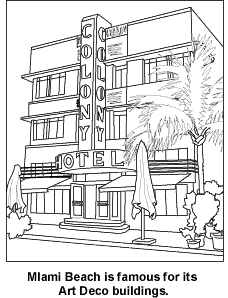| Home > Florida Then & Now > Supplemental Florida Reading Passages > Tourism in Florida | |
Tourism in Florida
During Florida's early days, only wealthy and famous people could afford to vacation there. Some were so fond of Florida that they decided to stay and farm or start another business. Henry S. Flagler was one of those people who fell in love with the Sunshine State and he decided to invest in Florida after a visit in 1883. He began to invest his wealth by building hotels and railroads in Florida. As the railroads grew, it was easier for people to travel to Florida. By 1890, the railways were completed and travel to Florida was made easy for people as far away as New York.
In the early 1900s, thousand of tourists were coming to Florida. They came to stay in the new hotels, rest in the warm weather, enjoy the natural beauty, and some even came to recover from illnesses. Many wealthy people, such as Thomas Edison, Harriet Beecher Stowe, and Henry Ford, built winter homes in Florida and visited for months at a time.
The invention of the automobile also made travel easier for people. As cars became less expensive and people had more leisure time, more people had time to go on vacation. Hotels and resorts were still expensive, so some travelers brought their own beds and food. They slept in their cars. Since their food was usually in tin cans, these travelers were known as "tin-can tourists."
In the 1930s, airlines opened up travel schedules to Florida. This provided the way for even more tourists to travel to Florida. Airports were built in major cities, making travel easier for tourists into and around Florida.
In the 1930s, architects designed buildings in Miami Beach in a style called Art Deco. This cheerful, colorful style was popular in the Depression era. Visitors are still atracted to the Art Deco district.
After World War II, the tourist industry quickly became Florida's biggest source of income. At first, the only thing for tourists to see was the natural beauty of Florida. The miles of white sandy beaches, the Everglades with its alligators, panthers and birds, the Florida Keys, with its coral reefs and sport fishing, and the forests of the national parks attracted many nature lovers. There were activities such as fishing, hiking, boating, and swimming taking place throughout the state, but above all, the visitors came to soak up the sun and relax.

There are theme parks built all over Florida. In 1971, Florida became home to one of the largest resorts in the world, Walt Disney World Resort. In the first year, this 28,000-acre park brought about $14 billion dollars to Orlando's economy. This one resort is like a city in itself. It includes Disney's Magic Kingdom, Epcot Center, the MGM Movie Studio center, Camp Wilderness, Islands of Adventure, and Animal Kingdom. This theme park has continued to grow throughout the last thirty years and has encouraged other developers to build many other attractions in Florida.
In addition to Walt Disney World Resort, the Orlando area is also home to Sea World, Cypress Gardens, and Universal Studios. In fact, Orlando is the biggest vacation spot in Florida. On the west coast, Busch Gardens and Lowry Park Zoo are two popular attractions. Tampa Bay has hosted two Super Bowl Games. On the east coast is Kennedy Space Center's Spaceport USA. With the popularity of boat cruises increasing, Florida waters have become a major location for people taking cruises in the Caribbean.
Today, tourism is the most important factor driving Florida's economy. About forty million people visit Florida yearly. The money visitors spend in Florida supports many businesses. Amounting to over $40 billion dollars each year, tourism is the state's greatest source of income. As tourism continues to grow, so will Florida.
| Home > Florida Then & Now > Supplemental Florida Reading Passages > Tourism in Florida |
Exploring
Florida: A Social Studies Resource for Students and Teachers
Produced by the Florida Center for Instructional
Technology,
College of Education, University of South Florida © 2002.